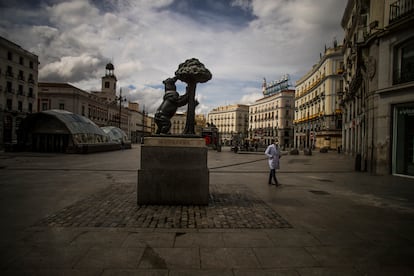Spain’s economy posts historic 18.5% quarterly fall due to coronavirus lockdown
New data shows that output has fallen to levels not seen since the late 19th and early 20th centuries

The economic cost of containing the Covid-19 pandemic in Spain is just now beginning to emerge. Between April and June, the economy sank an unprecedented 18.5%, according to a flash estimate provided by the National Statistics Institute (INE) on Friday.
This is the largest quarterly drop since the days of the Spanish Civil War (1936-1939), and it comes on top of a 5.2% contraction in the first three months of the year, reflecting the fact that the country went into lockdown in mid-March. The coronavirus confinement measures were lifted in mid-June.
This means that during the first half of the year, a fourth of Spain’s gross domestic product (GDP) went up in smoke due to the strict restrictions introduced to curb the coronavirus epidemic. The lost production amounts to around €300 billion, a figure that would be enough to cover pension payments for Spain’s 10 million retirees for two years.
The lost production amounts to around €300 billion, a figure that would be enough to cover pension payments for Spain’s 10 million retirees for two years
According to the INE, on an annual basis Spain’s GDP shrank by 22.1%. The numbers show that the coronavirus crisis has ended six years of steady growth that followed a prolonged recession triggered by the 2008 financial crisis.
The figures in Spain are worse than in other developed economies affected by the Covid-19 pandemic that have recently released their own indicators. Germany’s economy shrank 10.1% in the first quarter; the United States contracted by 9.5%, and France shed 13.8%.
This reflects two realities. On one hand, Spain was forced to adopt stricter containment measures than other countries, a fact that is supported by mobility reports published by Google. On the other, the Spanish economy is more dependent on tourism – which contributes 12.3% to GDP – and other services that rely on human interaction. This puts Spain in a more vulnerable position to undo the economic damage caused by the pandemic.
The Spanish economy is more dependent on tourism and other services that rely on human interaction
The INE’s historical data goes back to 1970, and shows nothing nearly as bad as this year’s figures. Even during the worst of the previous crisis, in the first quarter of 2009, GDP only shrank 2.6%. To find anything similar to 2020, it is necessary to look back at the 20th and even 19th centuries.
Estimates by the economic historian Leandro Prados de la Escosura show that in 1936, the Spanish economy sank at an annual rate of 26.8%, for an average of 6.7% each quarter. Historians have also calculated that in 1868 the economy lost 13.3% due to a financial crisis caused by railway investments and bad crops. In 1896, GDP contracted by 10% as the country grappled with the Cuban War of Independence.
The data released on Friday confirms the forecasts made by the Bank of Spain, which had been expecting the economy to show a fall of anywhere between 16% and 21.8% in the second quarter.
English version by Susana Urra.
Tu suscripción se está usando en otro dispositivo
¿Quieres añadir otro usuario a tu suscripción?
Si continúas leyendo en este dispositivo, no se podrá leer en el otro.
FlechaTu suscripción se está usando en otro dispositivo y solo puedes acceder a EL PAÍS desde un dispositivo a la vez.
Si quieres compartir tu cuenta, cambia tu suscripción a la modalidad Premium, así podrás añadir otro usuario. Cada uno accederá con su propia cuenta de email, lo que os permitirá personalizar vuestra experiencia en EL PAÍS.
¿Tienes una suscripción de empresa? Accede aquí para contratar más cuentas.
En el caso de no saber quién está usando tu cuenta, te recomendamos cambiar tu contraseña aquí.
Si decides continuar compartiendo tu cuenta, este mensaje se mostrará en tu dispositivo y en el de la otra persona que está usando tu cuenta de forma indefinida, afectando a tu experiencia de lectura. Puedes consultar aquí los términos y condiciones de la suscripción digital.
More information
Últimas noticias
The metaverse, four years later: Is it finished or just at a standstill?
$3,000 and a plane ticket: The United States increases incentives for migrants to self-deport before the end of the year
Charles Dubouloz, mountaineering star, retires at 36 with a farewell tour inspired by Walter Bonatti
From the White House to diplomatic gifts: Lego wins over adult fans, brick by brick
Most viewed
- The low-cost creative revolution: How technology is making art accessible to everyone
- Christian Louboutin: ‘Young people don’t want to be like their parents. And if their parents wear sneakers, they’re going to look for something else’
- All the effects of gentrification in one corner of Mexico’s Colonia Roma
- Liset Menéndez de la Prida, neuroscientist: ‘It’s not normal to constantly seek pleasure; it’s important to be bored, to be calm’
- Christmas loses its festive spirit: ICE fears cast shadow over religious celebrations











































